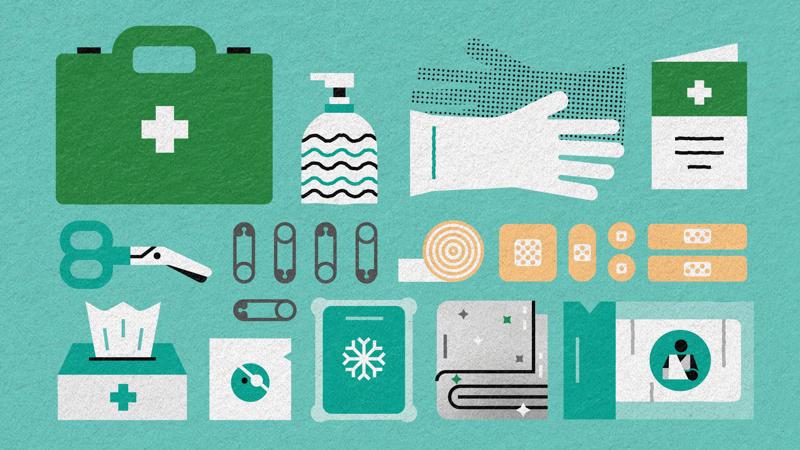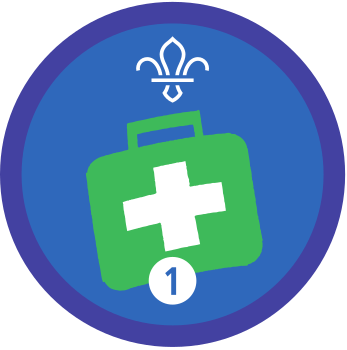
Be an emergency aider: head injuries
You’ll need
- Big pieces of paper
- Sticky tack
- Pens or pencils
- Bandages
Before you begin
- Make sure the person leading the activity knows about first aid. Someone from your group or local area with a first aid certificate could take charge, or you could reach out to places that help provide first aid training or support, for example, St John Ambulance or the British Red Cross.
- You’ll need enough leaders for the activity, including enough people who are happy to demonstrate first aid techniques.
- Adults should only demonstrate and practise first aid on other adults; young people should only demonstrate and practise first aid on other young people. Adults and young people should never demonstrate or practise first aid on each other.
- Remember that this activity touches on topics that might be sensitive for some people. Give everyone the opportunity to step away if they need to compose themselves.
This could be for a number of reasons including things that people may have experienced. Make sure they have a space to go to or someone to talk to if they need it. If needed, have a look at our information on bereavement.
- Make sure you have enough bandages for everyone to practise – this is a great chance to use up any out-of-date supplies to save breaking into your first aid kit.
- Write ‘AVPU’ down the left edge of the A3 paper and stick it up somewhere everyone will be able to see it.
Learn what to do
- Everyone should chat about head injuries. Talk about what can cause them and the differences between minor and serious head injuries.
- Have a quick chat about the signs and symptoms of minor head injuries.
- Explain to everyone about the AVPU scale. Talk about how it involves checking alert, verbal, pain, and unresponsive, and write each word on the piece of A3 paper for everyone to see.
- Show everyone how to treat someone who has a minor head injury, including putting on a bandage. They should use another adult as the casualty and explain what they’re doing every step of the way.
You can find more information on head injuries in adults on the St John Ambulance website, or below.
- Everyone should get into pairs of young people. They should take it in turns to practise putting a bandage on their partner’s head. Make sure some adults are walking around so they can help if anyone’s finding it tricky.
- Once everyone’s finished practising, they should gather back together.
- Next, explain how serious head injuries are different to minor head injuries. Talk everyone through the signs and symptoms and what a first aider would do.
Make sure everyone understands that the casualty may be less responsive (or unconscious) and that it’s very important to call 999 as soon as possible. You can find more information on head injuries in adults on the St John Ambulance website, or below.
For detailed and up-to-date information, check out the St John Ambulance website.
- Alert: Are they alert? Are their eyes open?
- Verbal: Can they respond to you if you talk to them? Can they answer simple questions?
- Pain: Does the casualty respond to pain? If you pinch their ear lobe, do they move or open their eyes?
- Unresponsive: Are they unresponsive to all the above? If they’re unresponsive (or you’re worried), call 999 for emergency help.
For detailed and up-to-date information, check out the St John Ambulance website.
Signs and symptoms include:
- any loss of responsiveness
- scalp wound
- dizziness or feeling sick
- loss of memory of events before or during the injury
- headache
- confusion
Treating a minor head injury involves holding an ice pack against the casualty’s head, assessing their level of response with the AVPU scale, treating any wounds, and calling 999 if they’re unresponsive or if you’re worried.
For detailed and up-to-date information, check out the St John Ambulance website.
Signs and symptoms include:
- experienced a severe blow to the head
- increased drowsiness
- persistent headache
- dizziness and confusion
- loss of balance or memory
- difficulty speaking or walking
- vomiting episodes
- double vision
- seizure
- deteriorating level of response
- unresponsive
- blood or blood stained watery fluid coming from the ear or nose
- unequal pupil size
Treating a severe head injury involves calling 999, monitoring the casualty, and preparing to do CPR if necessary. You should try not to move the casualty in case they have a spinal injury – only move them if they’re in danger.
Reflection
This activity was all about developing skills and being responsible. Understanding the difference between minor and severe head injuries and knowing what to do could help save someone’s life. Can anyone remember the acronym for checking a person’s responsiveness? People could remind themselves of what each of the letters in AVPU means. Some activities have a higher risk of head injuries: can anyone think of activities with a very low or slightly higher risk? People could think about playing board games compared to adventurous activities and sports like horse riding and rugby. Why is it important that people playing sports or having adventures know what to do in an emergency?
Safety
All activities must be safely managed. You must complete a thorough risk assessment and take appropriate steps to reduce risk. Use the safety checklist to help you plan and risk assess your activity. Always get approval for the activity, and have suitable supervision and an InTouch process.
If anyone can’t reach their casualty, or is unable to do things like bandage their head, they can still learn so they can instruct others. They may want to get into a group of three, so they can tell a third person what to do to help the casualty.
All Scout activities should be inclusive and accessible.
Put people’s skills to the test by creating some scenarios in your meeting place. Once groups enter, they’ll need to do a primary survey to work out what they need to do. You could also combine the skills people learned in this activity with other emergency aid skills and organise an incident hike.
Young people with first aid qualifications could help others if they’re struggling, with a leader supervising.
